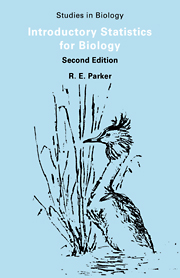Book contents
- Frontmatter
- Contents
- How to use this book
- 1 Probability and Statistics
- 2 Continuous Distributions: Confidence Limits
- 3 Continuous Distributions: Tests of Significance
- 4 Discontinuous Distributions: Binomial Distribution
- 5 Discontinuous Distributions: Poisson Distribution
- 6 Analysis of Frequencies: Single Classification
- 7 Analysis of Frequencies: Double Classification
- 8 Interrelationships of Quantitative Variables
- 9 Analysis of Variance: Single Classification
- 10 Analysis of Variance:Double Classification
- Solutions to Problems
- Further Reading
- Selected Statistical Tables
6 - Analysis of Frequencies: Single Classification
Published online by Cambridge University Press: 05 June 2012
- Frontmatter
- Contents
- How to use this book
- 1 Probability and Statistics
- 2 Continuous Distributions: Confidence Limits
- 3 Continuous Distributions: Tests of Significance
- 4 Discontinuous Distributions: Binomial Distribution
- 5 Discontinuous Distributions: Poisson Distribution
- 6 Analysis of Frequencies: Single Classification
- 7 Analysis of Frequencies: Double Classification
- 8 Interrelationships of Quantitative Variables
- 9 Analysis of Variance: Single Classification
- 10 Analysis of Variance:Double Classification
- Solutions to Problems
- Further Reading
- Selected Statistical Tables
Summary
Two frequencies and more
The data resulting from biological surveys and experiments are of two main types. In one, each individual, item or event is characterized by a measurement or some other kind of quantitative assessment. In the other type, each individual is placed into a particular class and interest is centred on the frequencies with which individuals fall into these. We have learnt, in Chapters 2 and 3, how to deal with measurement data for one or two samples. In Chapters 4 and 5 we have seen how these methods may be extended to cover situations in which the assessment of a sample (and hence of its parent population) is made in terms of counts of individuals in certain classes, e.g. percentage germination. In many biological investigations however the hypotheses we have to test have nothing to do with quantitative assessment of individuals or samples but relate directly to the probabilities, and hence the frequencies, with which individuals or observations fall into specified classes.
Essentially we have a finite number of observations which are classified into two or more classes. Hypothesis leads us to expect the observations to fall into these classes in particular proportions, and hence in particular frequencies. In general there are deviations between the observed and expected frequencies so we need both an overall measure of the deviations and a method of estimating the probability of such deviations from expectation occuring in order to provide a test of significance.
- Type
- Chapter
- Information
- Introductory Statistics for Biology , pp. 38 - 42Publisher: Cambridge University PressPrint publication year: 1991



